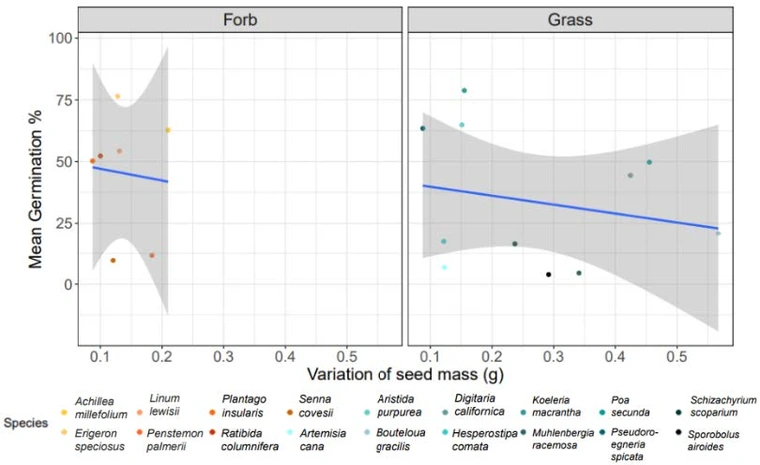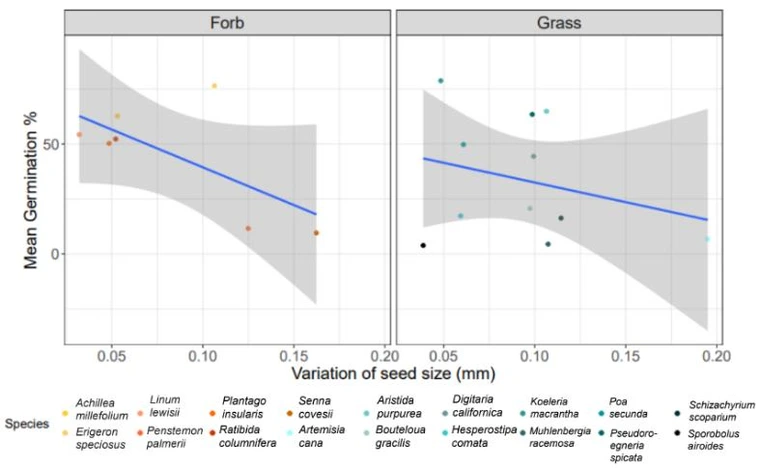Ecological restoration is increasing in importance with the persisting climate crisis. Successful seed-based restoration is challenging in arid systems; this is in part because seedlings are most vulnerable during the transition between seed and seedling. Practitioners may be able to improve restoration outcomes using easily measurable seed characteristics (e.g., size and mass) if these characteristics are related to germination rates. Established research in the field of ecology has found larger seeds tend to have the highest germination percentage in less time, when compared to small or medium sized seeds (Ahirwar, 2015). The ability for greater resource storage and starch access can be attributed to seeds of larger sizes having enhanced germination and growth rates (Ahirwar, 2015). However, the effect of variation in seed characteristics on germination is substantially overlooked in ecological research. Here, we explore if there is a relationship between variation in seed size or seed mass and germination percentage. It will also be determined if the relationship between seed characters and percent germination vary by function groups (i.e., grasses and forbs).
Methods
Seven forb species and eleven grass species native to the Southwest region of North America were chosen for this germination study. The following forb species were used: Achillea millefolium (common yarrow, perennial), Linum lewisii (blue flax, perennial), Erigeron speciosus (aspen fleabane, perennial), Penstemon palmerii (Palmer’s penstemon, perennial), Plantago insularis (desert plantain, annual), Ratibida columnifera (prairie coneflower, perennial), and Senna covesii (desert senna, perennial). For grass species, the following were chosen: Artemisia cana (silver sagebrush, perennial), Aristida purpurea (purple three-awn, perennial), Bouteloua gracilis (blue grama, perennial), Digitaria califonica (Arizona cottontop, perennial), Hesperostipa comata (needle-and-thread-grass, perennial), Koeleria macrantha (prairie junegrass, perennial), Muhlenbergia racemosa (marsh muhly, perennial), Poa secunda (sandberg bluegrass, perennial), Pseudoroegneria spicata (bluebunch wheatgrass, perennial), Schizachyrium scoparium (little bluestem, perennial), and Sporobolus airoides (alkai sacaton, perennial). The seeds from the two functional groups differed in both size and mass (Figure 1).
For each forb and grass species, five petri dishes with seed count ranging from 20 to 100 seeds were germinated in the lab. The plates were watered daily to ensure the base remained damp. The total seed count and the total number of germinates for each petri dish per species were recorded over a three-week period. Seed length was collected by measuring five seeds per species in millimeters with a VINCA DLCA-0605 digital caliper. Five seeds per species were weighed with a XSR105 DualRange scale to record seed mass.

Figure 1. Variation in seed size of the forb and grass species.
Results
Graphs were created from analysis of the collected seed data to display the relationship between seed mass and mean germination. The same process was followed to compare seed size and mean germination. The calculation focus was the following:

Figure 3 presents the relationship between seed mass variation and germination mean for the different forb and grass species. Although there was a negative relationship detected between the two variables, this relationship was not statistically significant. Similarly, for seed size variation and germination mean of the forb and grass species, no statistically significant relationship was found (Figure 4). However, there was a general trend observed for species with lower variation in seed size to have a higher mean germination rate.

Figure 3. Variation of Seed Mass (g) vs Germination Mean

Figure 4. Variation of Seed Size (mm) vs Germination Mean
Implications and future directions
The negative relationship observed between the variation of seed size and mean germination for both forb and grass species suggests practitioners may want to select species with low variation in seed size to maximize germination likelihood. However, seed germination may not directly correlate to long term plant establishment. When a high number of seeds germinate in a short time, there is also the potential risk of high plant mortality. To further understand the relationship between germination and seed characteristics, future research can focus on the impact of germination time and differing environmental conditions. Manipulating light, water, and temperature, as well as planting the seeds in varying depths of soil, may reveal significant differences in germination mean for variating seed characteristics.
References
Ahirwar, J. (2015). Seed Germination of Alangium Lamarckii (Akola). The Indian Forester, 141, 815-816.

